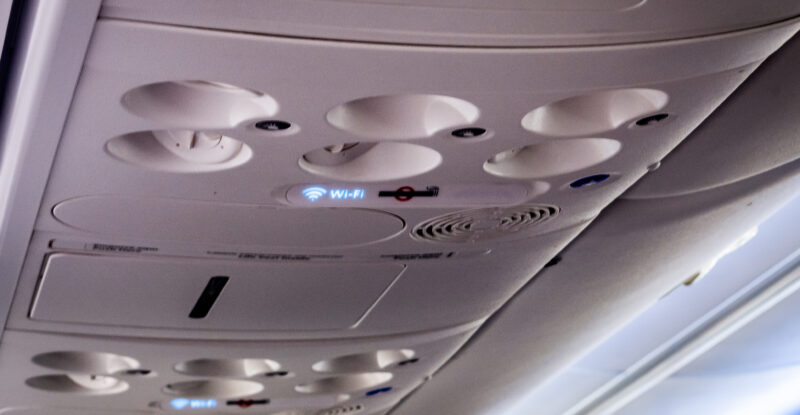Even as its Ku-band, multi-orbit LEO/GEO electronically steerable antenna (ESA)-based inflight connectivity solution moves from strength to strength — the kit is installed on ~300 aircraft, is receiving high praise from Air Canada, and is about to roll out on five airlines in APAC – SES assures it is “totally committed” to its Open Orbits ecosystem, as powered by its Ka-band MEO and GEO satellites.
That commitment holds true “now and in the future,” senior product executive Blane Boynton told RGN during a sit-down interview at the McLean, Virginia-based offices that SES inherited as part of its acquisition of Intelsat. “And in fact, we want to bolster Open Orbits and bring more choice, more network, more capability there,” he said.
One way to do that would be to pair the ThinKom Solutions Ka2517 VICTS antenna that supports Open Orbits with a Ku-band LEO-only ESA and offer a Ka/Ku multi-band, multi-orbit, multi-network solution inclusive of the Eutelsat OneWeb LEO service for which SES is now a distribution partner in aero.
“What we’re looking at is, how do we make Open Orbits, Ku and Ka work together,” Boynton confirmed to RGN. He said SES is both “talking internally” about that kind of solution as a retrofit option and speaking with Airbus about it, as the European airframer is presently honing its linefit supplier-furnished HBCplus program to accommodate the new NGSO constellations and the rapidly evolving IFC landscape. SES is a managed service provider on the Ka-band side of HBCplus, and now, after acquiring Intelsat, it’s also a MSP on the Ku-band side.
Decisions from Airbus forthcoming
Airbus is understood to be gearing up to provide more clarity on its HBCplus tweaks soon. And satellite operators and service providers on the program, including Amazon Project Kuiper in the Ka-band, approve of the more flexible direction the airframer is headed, RGN can confirm.
There is of course some precedent to the type of architecture SES is exploring, as Hughes Network Systems was first out of the gate with a multi-orbit, multi-band, multi-network IFC system which has been selected by Delta and uses Ka2517 for GEO and Hughes’ LEO-only Ku-band ESA talking to Eutelsat OneWeb. And Airbus is already eyeing how it can support Delta as it brings the Hughes solution to its new-delivery A321neos and A350s.
But SES’s Ka2517-based Open Orbits service in standalone form, i.e. without a LEO component as presently available and delivering under HBCplus and as a retrofit option, also has legs to grow.
“We’re really happy with the work that our partners NSG have done today,” said Robert Knapel, SES’s VP, chief of staff, Aviation Business Unit, of its aero ISP partner serving the Middle East and beyond.
Knapel touted the optionality of this partnership approach. “It goes back to flexibility. There are certain regions where having channel partners are going to make a lot more sense. They have the connections, they have the relationships, they have the know-how to win and serve geographies that historically we may not have performed in … and then, obviously, for regulatory with China, as you know, having a local partner is the only way there is.”
SES also offers the GEO-focused (formerly Intelsat) 2Ku solution, which is based on ThinKom’s Ku3030 hardware, as well as the aforementioned multi-orbit Ku-band ESA-based solution that is rolling out at American Airlines, Air Canada, APAC carriers and others, as supported by Gilat’s Stellar Blu ESA hardware.
A former Intelsat and Gogo executive, SES’s Boynton explained that, with the Intelsat acquisition, SES’s value proposition has matured.
We had 2Ku for a long time, and then we brought the ESA to market and we tried to be dispassionate about it. We tried to offer both for some period of time. Whichever one meets your needs; we’ll tell you the merits of both. You pick the one that matches your airline.
And now you’re going to see, I think, an extension and a maturation of that model, where we go in and say, ESA, VICTS, Ku, Ka, we’ll tell you what’s good about both of them, and you decide which one’s right for you.
Should SES push forward with the multi-band VICTS + LEO-only ESA architecture, it would be able to offer LEO/MEO/GEO connectivity to airlines, which would be a differentiator for the satellite operator and aero ISP.
Discussions about the configuration — do you put both antennas in one big mega-OAE or do you split them — are taking place. “I’m on the ‘split them’ path, but I’m sure it’s a cocktail conversation that folks could argue both sides of, but that’s what we see,” Boynton said, adding
You know, getting to multi-beam is the next outcome that the industry needs.
Two-terminal acceptance; and the changing face of the ‘hump’
Of note: SES doesn’t think dual-beam ESAs (one aperture, simultaneously connecting to GEO or MEO, and LEO) are ready for primetime in commercial aviation, not because of heat dissipation generally, but because “the technology is just not there. It’s complicated.”
“If you look at what’s happened in the industry,” he said, “you’re starting to see two terminals being acceptable. I would not have guessed that but that’s where we are. So that’s a gift.” The competition has two terminals, he continued, “and I think that’s probably the most credible path to multi beam.”
Additionally, SES, whose single-beam multi-orbit ESA does not use a radome, increasingly doesn’t see a need for radomes, period — even if it adopts the multi-band VICTS+LEO-only ESA architecture. “I think we believe that radomes are a thing of the past,” Boynton said.
David Cronin, who serves as VP Commercial Aviation Operations, added: “Many of them have wind requirements where, when the wind is above, I think it’s 12 knots, generally, you can’t do maintenance outside. So, it just becomes operationally difficult for airlines to have to manage a big sail that they have to then put somewhere and deal with what they’re dealing with, and put it back on. So that’s the nice thing about a radome-less install.”
Boynton noted that for nextgen IFC installs: “you need a cover that’s not a radome, so you need something flat. So, if you look at some of the smaller NGSO-only ESAs at market, maybe you want to look at what Gogo did with Hughes; that doesn’t have a classical radome, it has a cover. That’s a lot easier to deal with because …[it’s] integral to the antenna panel. So, you either need an integral cover type solution, or you need a flat surface solution, like we did with our ‘nine by nine’ [multi-orbit ESA based on Gilat Stellar Blu ESA].” Notably, SES owns most of the STCs for the aircraft being fitted with its multi-orbit ESA-based offering (and installation time is down to 48 hours; even 36 hours in some instances, and being burned down further right now).
SES’s stance on radomes syncs nicely with the work Boeing is doing to make the Gilat Stellar Blu ESA linefit offerable. (Whilst the Gilat Stellar Blu ESA hardware is on a separate offerability track than the service providers at Boeing, SES is still confident that 737s will roll off the line with its linefit service in 2026.)
Boeing showcased a half-scale model of a shroud-like structure at this year’s Aircraft Interiors Expo in Hamburg, with cut-out like areas for RF transparent parts. Interestingly, ThinKom CTO Bill Milroy recently told RGN that Ka2517, which is linefit offerable as buyer furnished equipment at Boeing, can fit into that new shroud footprint. “And so,” he said, “we’re in the process of talking to Boeing to say, ‘hey, would this be consistent with your vision of the shroud?”
What’s clear is that SES is going to be armed with multiple IFC options for airlines including those that address multi-network, multi-band, and multi-beam.
“Our job is to meet the needs of each unique airline. And as you know, they’re all different in terms of what they’re looking for and what’s most important,” said Knapel. The “maturity of the digital product portfolio that Intelsat brings to the table” is something that now SES can also take advantage of, he added.
The fact that Eutelsat OneWeb is an enterprise grade network also has big benefits. But interestingly, despite its LEO/GEO ESA offering and its VICTS + LEO-only ESA studies, SES doesn’t believe that LEO is essential for a great IFC experience.
“I’d say having NGSO as a component of your portfolio is necessary. The performance that we’ve seen is the MEO satellites today are delivering the same kind of customer experience as we’re seeing on the LEO satellites,” Knapel said. “So, you know, having that NGSO layer with the GEO backbone supporting it means you’re going to have a high-quality customer experience with the resiliency and redundancy on a global basis that you need to have a surety of service.”
Related Articles:
- SES eyes land mobility comms opportunities on airport ramps
- Air Canada extols virtues of SES multi-orbit IFC, nears E175 installs
- SES completes Intelsat buy with FCC blessing
- Panasonic Avionics secures more customers for Gilat ESA-based multi-orbit IFC
- Panasonic adds LEO-only IFC antenna including for GEO augment
- VIDEO: Delta innovates with Hughes partnership, IFEC integration
Featured image credited to istock.com/Herbert Pictures












